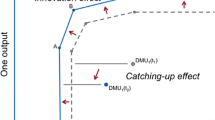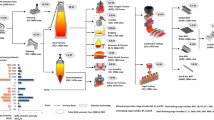Abstract
European steel producers need to increase energy efficiency and reduce CO2 emissions to meet requirements set by European policies. Robust indicators are needed to follow up these efforts. This bottom-up analysis of traditional energy and climate indicators is based on plant-level data from three Swedish steel producers with different product portfolios and production processes. It concludes that indicators based on both physical and economic production are interlinked with aspects both within and outside the company gates. Results estimated with partial least squares regression confirm that steel production has complex relationships with markets, societal context, and operational character of the industry. The study concludes that (i) physical indicators (based on crude steel production) may be useful at the process level, but not at the industry-wide level, (ii) the value added is not a reliable alternative since it cannot be properly estimated for companies belonging to larger international groups, and (iii) structural shifts may influence the results significantly and veil improvements made at the process level. Finally, harmonised system boundary definitions are vital for making indicators comparable between companies. The use of traditional indicators, as defined today, may lead to uninformed decisions at the company as well as policy levels.






Similar content being viewed by others
Notes
In an integrated steel mill, steel is produced from iron ore using a blast furnace and a basic oxygen furnace. An integrated mill covers the whole chain of production, including coke production, steel production as well as rolling and finishing processes.
In contrast to correlation, which is a linear relationship between two variables, multi-collinearity indicates that a linear relationship exists between the variable and another variable or with a linear combination of a set of other variables (Alin 2010).
Carbon leakage is the phenomenon of CO2 emissions increasing elsewhere as a result of implementing regional regulations to reduce emissions (i.e. the Kyoto Protocols mitigation policy’s pressure on Annex B countries that could result in emissions increasing in non-Annex B countries) (Peters and Hertwich 2008).
References
Abdi, H. (2010). Partial least squares regression and projection on latent structure regression (PLS regression). Wiley Interdisciplinary Reviews: Computational Statistics, 2(1), 97–106.
Alin, A. (2010). Multicollinearity. Wiley Interdisciplinary Reviews: Computational Statistics, 2(3), 370–374.
Arens, M., Worrell, E., & Schleich, J. (2012). Energy intensity development of the German iron and steel industry between 1991 and 2007. Energy, 45(1), 786–797.
Natural Resources Canada. (2011). Industrial Consumption of Energy (ICE) Survey: summary report of energy use in the Canadian manufacturing sector, 1995–2009. Ottawa: Natural Resources Canada.
Chong, I.-G., & Jun, C.-H. (2005). Performance of some variable selection methods when multicollinearity is present. Chemometrics and Intelligent Laboratory Systems, 78(1–2), 103–112.
European Commission. (2003). Directive 2003/87/EC of the European Parliament and of the Council of 13 October 2003 establishing a scheme for greenhouse gas emission allowance trading within the community and amending Council Directive 96/61/EC. Official Journal of the European Union, 275, 32–46.
European Commission. (2006). Directive 2006/32/EC of the European Parliament and of the council on energy end-use efficiency and energy services and repealing Council Directive 93/76/EEC. Official Journal of the European Union, 114, 64–85.
European Commission. (2009). Directive 2009/29/EC of the European Parliament and of the Council of 23 April 2009 amending Directive 2003/87/EC so as to improve and extend the greenhouse gas emission allowance trading scheme of the community. Official Journal of the European Union, 140, 63–87.
European Commission. (2012). Directive 2012/27/EU of the European Parliament and of the Council of 25 October 2012 on energy efficiency, amending Directives 2009/125/EC and 2010/30/EU and repealing Directives 2004/8/EC and 2006/32/EC. Official Journal of the European Union, 315, 1–56.
Denham, M. C. (2000). Choosing the number of factors in partial least squares regression: estimating and minimizing the mean squared error of prediction. Journal of Chemometrics, 14(4), 351–361.
ECORYS SCS Group (2008). Study on the Competitiveness of the European Steel Sector—within the Framework Contract of Sectoral Competitiveness Studies—ENTR/06/054. In: ECORYS SCS Group for European Commission DG Enterprise & Industry. Internet Resource. http://ec.europa.eu/enterprise/sectors/metals-minerals/files/final_report_steel_en.pdf. Accessed 16 Dec 2011.
Efron, B., & Tibshirani, R.J. (1993). An introduction to the bootstrap. New York: Chapman & Hall.
Eichhammer, W., & Mannsbart, W. (1997). Industrial energy efficiency. Energy Policy, 25(7–9), 759–772.
Enerdata. (2012). Definition of energy efficiency indicators in ODYSSEE data base. Grenoble: Enerdata.
Farla, J. C., & Blok, K. (2000). The use of physical indicators for the monitoring of energy intensity developments in the Netherlands, 1980–1995. Energy, 25(7), 609–638.
Farla, J. C., & Blok, K. (2001). The quality of energy intensity indicators for international comparison in the iron and steel industry. Energy Policy, 29(7), 523–543.
Frank, I. E., & Friedman, J. H. (1993). A statistical view of some chemometrics regression tools. Technometrics, 35(2), 109–135.
Giacone, E., & Mancò, S. (2012). Energy efficiency measurement in industrial processes. Energy, 38(1), 331–345.
Hasanbeigi, A., Morrow, W., Sathaye, J., et al. (2013). A bottom-up model to estimate the energy efficiency improvement and CO2 emission reduction potentials in the Chinese iron and steel industry. Energy, 50, 315–325.
Hastie, T., Tibshirani, R., & Friedman, J. (2008). The elements of statistical learning—data mining, inference and prediction. Stanford, California: Springer.
He, Y., Li, Y., & Zhao, X. (2012). Analysis of energy saving potential of power industry in China based on multiple liner regression model. Presented at 2012 8th International Conference on Computing Technology and Information Management (ICCM), 24–26 April 2012, Seoul, Korea.
Swedish Meteorological and Hydrological Institute (2013). Temperature statistics (Dataserier för observationsstationer). Internet Resource. http://www.smhi.se/klimatdata/meteorologi/dataserier-2.1102. Accessed 5 Dec 2013.
Johansson, M.T. (2014). Improved energy efficiency within the Swedish steel industry—the importance of energy management and networking. In the PhD thesis, Improved Energy Efficiency and Fuel Substitution in the Iron and Steel Industry. Linköping: Linköping University.
Kandel, A., Sheridan, M., & McAuliffe, P. (2008). A comparison of per capita electricity consumption in the United States and California. Presented at 2008 ACEEE Summer Study on Energy Efficiency in Buildings Asilomar Conference Center Pacific Grove, California August 17–22, 2008.
Krämer, N., & Sugiyama, M. (2011). The degrees of freedom of partial least squares regression. Journal of the American Statistical Association, 106(494), 697–705.
Lapillonne, B. (2009). Evaluation and monitoring for the EU directive on energy end-use efficiency and energy services—annex to the summary report on top-down evaluation methods: ODYSSEE and ODEX indicators that can be used in top-down evaluation of energy savings (work packa). Wuppertal: Enerdata.
Lapillonne, B., & Pollier, K. (2012). Is industry energy efficiency back to pre-crisis trends in the EU. Fourth meeting of the project “Monitoring of EU and national eneryg efficiency targets” (ODYSSEE-MURE 2010), May 31st–June 1st 2012, Copenhagen, Denmark
Lin, B., Wu, Y., & Zhang, L. (2011). Estimates of the potential for energy conservation in the Chinese steel industry. Energy Policy, 39(6), 3680–3689.
Martens, H., & Martens, M. (2000). Modified jack-knife estimation of parameter uncertainty in bilinear modelling by partial least squares regression (PLSR). Food Quality and Preference, 11(1–2), 5–16.
McDonald, G. C. (2009). Ridge regression. Wiley Interdisciplinary Reviews: Computational Statistics, 1(1), 93–100.
Mevik, B.-H. (2007). VIP.R: implementation of VIP (variable importance in projection) for the “pls” package. Internet Resource. http://mevik.net/work/software/VIP.R. Accessed 31 Oct 2013.
Mevik, B.-H., & Cederkvist, H. R. (2004). Mean squared error of prediction (MSEP) estimates for principal component regression (PCR) and partial least squares regression (PLSR). Journal of Chemometrics, 18(9), 422–429.
Mevik, B.-H., & Wehrens, R. (2007). The pls package: principal component and partial least squares regression in R. Journal of Statistical Software, 18(2), 1–24.
Morfeldt, J., & Silveira, S. (2014). Capturing energy efficiency in European iron and steel production—comparing specific energy consumption and Malmquist productivity index. Energy Efficiency. doi:10.1007/s12053-014-9264-8.
Morfeldt, J., Nijs, W., & Silveira, S. (2014). The impact of climate targets on future steel production—an analysis based on a global energy system model. Journal of Cleaner Production. doi:10.1016/j.jclepro.2014.04.045.
Neelis, M., Worrell, E., Mueller, N., et al. (2009). Developing benchmarking criteria for CO2 emissions. Utrecht: ECOFYS Netherlands.
Oda, J., Akimoto, K., Tomoda, T., et al. (2012). International comparisons of energy efficiency in power, steel, and cement industries. Energy Policy, 44, 118–129.
Patterson, M. G. (1996). What is energy efficiency? Energy Policy, 24(5), 377–390.
Pérez-Lombard, L., Ortiz, J., & Velázquez, D. (2013). Revisiting energy efficiency fundamentals. Energy Efficiency, 6(2), 239–254.
Peters, G. P. (2008). From production-based to consumption-based national emission inventories. Ecological Economics, 65(1), 13–23.
Peters, G. P., & Hertwich, E. G. (2007). Post-Kyoto greenhouse gas inventories: production versus consumption. Climatic Change, 86(1–2), 51–66.
Peters, G. P., & Hertwich, E. G. (2008). CO2 embodied in international trade with implications for global climate policy. Environmental Science & Technology, 42(5), 1401–1407.
Phylipsen, G. J. M., Blok, K., & Worrell, E. (1997). International comparisons of energy efficiency—methodologies for the manufacturing industry. Energy Policy, 25(7–9), 715–725.
Sandberg, H., Lagneborg, R., Lindblad, B., et al. (2001). CO2 emissions of the Swedish steel industry. Scandinavian Journal of Metallurgy, 30(6), 420–425.
Schenk, N. J., & Moll, H. C. (2007). The use of physical indicators for industrial energy demand scenarios. Ecological Economics, 63(2–3), 521–535.
Siitonen, S., Tuomaala, M., & Ahtila, P. (2010). Variables affecting energy efficiency and CO2 emissions in the steel industry. Energy Policy, 38(5), 2477–2485.
Statistics Sweden (2013). Statistikdatabasen (the Statistical Database). Internet Resource. http://www.scb.se. Accessed 25 Sep 2013
Swedish Energy Agency (2011). Indikatorer och beräkningsmetoder för uppföljning av politik för energieffektivisering (Indicators and methods for follow-up of policies for energy efficiency). Internet Resource. http://energimyndigheten.se/sv/Press/Nyheter/Ny-rapport-Indikatorer-for-energieffektivisering/. Accessed 3 Feb 2012.
Swedish Environmental Protection Agency (2013). Emission factors. Internet Resource. http://www.naturvardsverket.se/Stod-i-miljoarbetet/Vagledningar/Luft-och-klimat/Berakna-utslapp-av-vaxthusgaser-och-luftfororeninga/. Accessed 20 Nov 2013.
Tanaka, K. (2008). Assessment of energy efficiency performance measures in industry and their application for policy☆. Energy Policy, 36(8), 2887–2902.
Wold, S., Sjöström, M., & Eriksson, L. (2001). PLS-regression: a basic tool of chemometrics. Chemometrics and Intelligent Laboratory Systems, 58(2), 109–130.
World Energy Council (2012). Energy efficiency indicators. Internet Resource. http://www.wec-indicators.enerdata.eu/. Accessed 22 Feb 2012.
World Energy Council. (2008). Energy efficiency policies around the world: review and evaluation. London: World Energy Council.
Worrell, E., Price, L., Martin, N., et al. (1997). Energy intensity in the iron and steel industry: a comparison of physical and economic indicators. Energy Policy, 25(7–9), 727–744.
Acknowledgments
The research was conducted independently by KTH Royal Institute of Technology but in close cooperation with Swedish steel industries. The authors would like to acknowledge the generous funding from the Swedish Energy Agency through the project “Robust Energy and Climate Indicators for the Steel Industry”.
Author information
Authors and Affiliations
Corresponding author
Appendix A
Appendix A
The appendix includes comparisons of results including coal and coke as energy carrier (denoted by “. Coal”) with the main results for the energy efficiency indicators presented in the paper. The variance explained by each PLSR model is given in the parenthesis. Factors marked in blue were chosen based on the VIP method. Factors marked in green were chosen based on the β-method.
Rights and permissions
About this article
Cite this article
Morfeldt, J., Silveira, S., Hirsch, T. et al. Economic and operational factors in energy and climate indicators for the steel industry. Energy Efficiency 8, 473–492 (2015). https://doi.org/10.1007/s12053-014-9296-0
Received:
Accepted:
Published:
Issue Date:
DOI: https://doi.org/10.1007/s12053-014-9296-0








